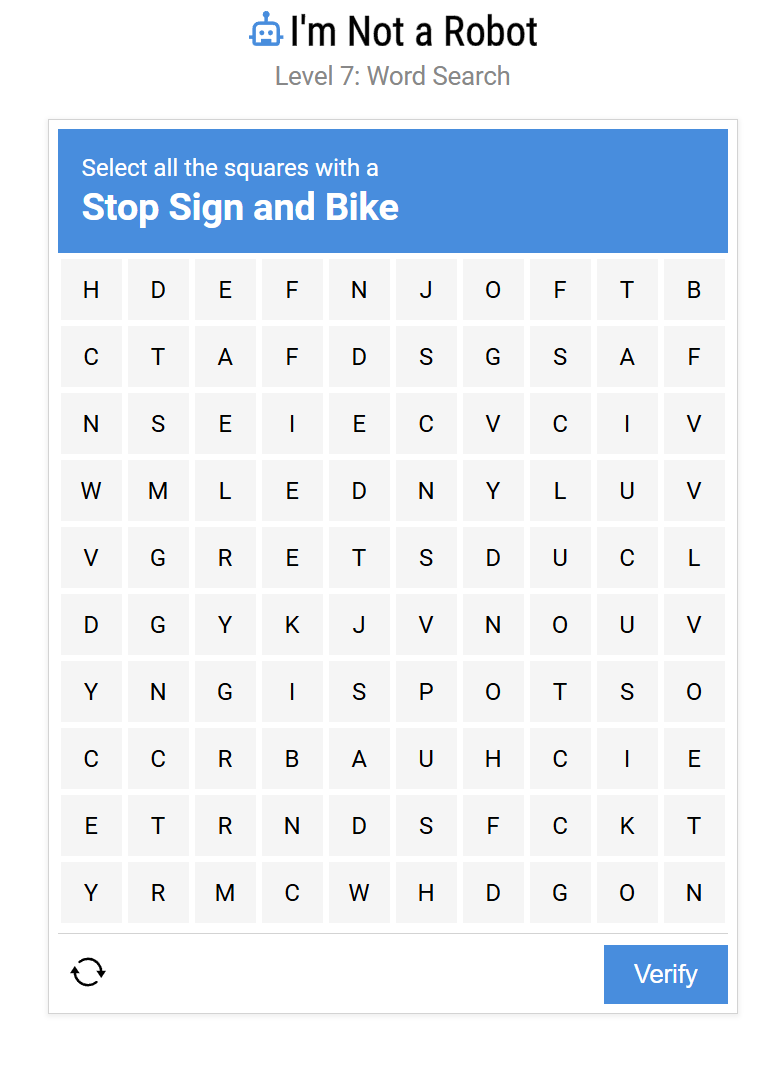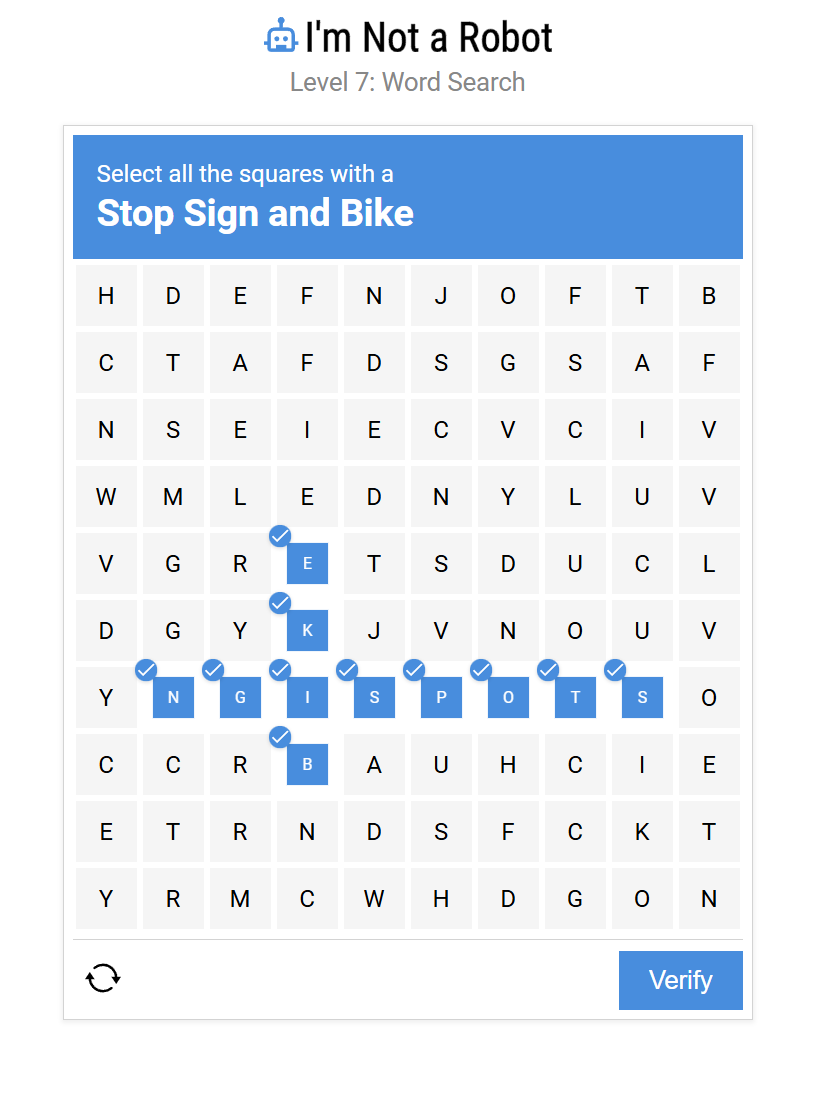How to Beat Level 7 in I'm Not a Robot - Word Search Guide
TL;DR
- Objective: Locate and select all instances of "STOP," "SIGN," and "BIKE" in Level 7's word search grid.
- Steps: Use systematic scanning techniques to find words in horizontal, vertical, and diagonal orientations.
- Verification: Select all letters of the three target words to advance to the next level.
- Risk: Missing letters or selecting incorrect sequences will result in puzzle failure, requiring grid reset.
This guide provides a comprehensive approach to conquering Level 7 of Neal.Fun's 'I'm Not a Robot' game, specifically the challenging word search puzzle. Players often struggle with this level due to the randomized letter placement and the need for systematic search strategies. This article presents proven techniques for efficiently locating target words in complex letter grids.
Unlocking Level 7: The 'I'm Not a Robot' Word Search Challenge Explained
Level 7 of Neal.Fun's 'I'm Not a Robot' game introduces a sophisticated word search puzzle that tests pattern recognition, systematic searching, and visual processing abilities. Unlike simple image recognition tasks, this challenge requires methodical analysis of a 10x10 letter grid to locate three specific words: "STOP," "SIGN," and "BIKE." The puzzle's complexity lies in the randomized letter placement and the multiple directional orientations in which words can appear.

Level 7 Word Search Grid
Mastering Word Search Strategy: A Step-by-Step Guide to Level 7
The key to successfully navigating Level 7 lies in implementing systematic search patterns and understanding the various orientations in which target words can appear. The puzzle requires locating three specific words within a grid of random letters, with words potentially oriented horizontally, vertically, or diagonally in any direction. Follow these strategic approaches to achieve efficient word location:
Step 1: Systematic Grid Analysis
- Objective: Establish a methodical approach to scanning the entire letter grid without missing potential word locations.
- Procedure: Begin with horizontal scanning, examining each row from left to right and right to left for the target words "STOP," "SIGN," and "BIKE." After completing horizontal analysis, proceed to vertical scanning, examining each column from top to bottom and bottom to top. Finally, conduct diagonal scanning in both directions (top-left to bottom-right and top-right to bottom-left) to ensure comprehensive coverage.
Step 2: Letter Pattern Recognition
- Objective: Identify distinctive letter combinations that indicate the beginning of target words.
- Procedure: Focus on locating starting letters S (for STOP and SIGN) and B (for BIKE) as anchor points for detailed examination. When you identify these letters, systematically check all eight surrounding directions for the continuation of target words. Pay particular attention to uncommon letters like K, G, and P, which appear less frequently and can serve as reliable indicators of target word locations.
Step 3: Sequential Letter Selection
- Objective: Accurately select all letters of identified words in the correct sequence.
- Procedure: Once you locate a target word, click each letter in the proper sequence to spell the complete word. Ensure you select every letter without skipping any, as incomplete selections will result in puzzle failure. Verify that your selection follows the word's directional orientation consistently throughout the entire letter sequence.

Level 7 Solution Example
Verification: Confirming Complete Word Selection
- Objective: Ensure all three target words are completely and correctly selected.
- Procedure: After selecting all letters for "STOP," "SIGN," and "BIKE," the system will process your selections. Successful completion typically results in the game advancing to the next level or displaying confirmation of puzzle solution. If the puzzle resets or indicates failure, re-examine your selections to identify missed letters or incorrect sequences.
Common Mistakes and Troubleshooting
- Incomplete letter selection: Missing even one letter from any target word will cause puzzle failure. Always double-check that every letter is selected.
- Incorrect directional following: Words maintain consistent directional orientation throughout their length. Ensure you follow the same direction for all letters in each word.
- Overlooking word intersections: Target words may share letters at intersection points. Account for these shared letters when making selections.
Behind the Puzzle: Decoding Neal.Fun's Word Search Logic
Neal.Fun's 'I'm Not a Robot' word search puzzle employs sophisticated letter placement algorithms that create challenging but solvable configurations. The puzzle design ensures that target words appear in various orientations while maintaining sufficient letter density to create visual complexity. Understanding these design principles helps players develop more effective search strategies and recognize common word placement patterns.
The puzzle's randomization creates unique configurations for each attempt, preventing players from memorizing specific solutions and requiring genuine pattern recognition skills. This design philosophy reflects the challenge's purpose: demonstrating human cognitive abilities that distinguish genuine users from automated systems. The word search format specifically tests visual processing and systematic analysis capabilities inherent to human cognition.
Pro Tips for Conquering 'I'm Not a Robot' Pattern Recognition Challenges
Mastering word search puzzles requires specific techniques that leverage human pattern recognition advantages. Beyond the specific Level 7 solution, certain approaches can significantly improve your success rate across similar visual challenges.
Tip 1: Prioritize Uncommon Letter Identification
- Objective: Use statistically rare letters as anchor points for efficient word location.
- Details: Letters like K, G, P, and combinations like ST appear less frequently in random letter grids, making them excellent starting points for systematic searches. When you locate these distinctive letters, focus intensive analysis on surrounding areas as they likely indicate target word proximity.
Tip 2: Employ Multiple Search Patterns
- Objective: Combine different scanning techniques to ensure comprehensive grid coverage.
- Details: Alternate between systematic row-by-row scanning and targeted letter-based searching. Use peripheral vision to identify potential word patterns while maintaining focused analysis on specific grid sections. This dual approach maximizes both efficiency and thoroughness in word location.
Tip 3: Utilize Visual Chunking Techniques
- Objective: Process letter groups rather than individual characters for improved pattern recognition.
- Details: Train your visual system to recognize common letter combinations (ST, OP, IGN, IKE) as unified patterns rather than separate letters. This chunking approach accelerates word recognition and reduces the cognitive load of processing individual characters sequentially.
Tip 4: Implement Strategic Grid Division
- Objective: Divide the search area into manageable sections to ensure systematic coverage.
- Details: Mentally divide the 10x10 grid into smaller sections (such as 5x5 quadrants) and complete each section thoroughly before moving to the next. This approach prevents oversight and ensures that no grid areas are inadvertently skipped during the search process.
Frequently Asked Questions About 'I'm Not a Robot' Word Search Strategy
Players often have similar questions when tackling Neal.Fun's 'I'm Not a Robot' pattern recognition challenges. Here are answers to some frequently asked queries:
-
Q1: Why does my word selection fail even when I find all the words?
-
A1: Level 7 requires selecting every letter of each target word in the correct sequence. Missing even one letter or selecting letters out of order will cause failure. Ensure you click each letter systematically and verify complete word selection before submission.
-
Q2: Can words appear backwards or in unusual orientations?
-
A2: Yes, target words can appear in any of eight possible directions: horizontal (left-right or right-left), vertical (top-bottom or bottom-top), and diagonal (in all four diagonal directions). Always check all orientations when examining potential word locations.
-
Q3: Do the target words ever overlap or share letters?
-
A3: Target words may intersect and share letters at crossing points. When this occurs, the shared letter counts toward both words. Be careful to select shared letters as part of both word sequences when making your selections.
-
Q4: What should I do if I can't locate one of the target words?
-
A4: If systematic scanning doesn't reveal a target word, try starting from uncommon letters and working outward, or use the refresh button to generate a new grid configuration. Sometimes a fresh grid provides clearer word placement patterns.
-
Q5: Are there visual cues that indicate correct word identification?
-
A5: Look for natural letter flow and consistent directional orientation. Correctly identified words will display smooth, continuous letter sequences without abrupt direction changes or gaps between characters.
Final Summary
Successfully conquering Level 7 of 'I'm Not a Robot' requires implementing systematic search strategies and maintaining thorough attention to letter selection accuracy. Victory depends on methodical grid analysis, pattern recognition skills, and precise sequential letter selection for all target words. To prepare for similar pattern recognition challenges, always employ systematic scanning techniques, focus on distinctive letter patterns, and remember that completeness and accuracy in selection are crucial for puzzle success.